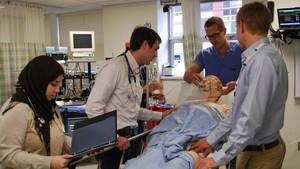Medical physics pairs the science of physics with medical diagnosis and treatment. Medical physicists are healthcare professionals with specialized training in the application of physics to areas such as cancer care and diagnostic imaging (viewing the inside of the body) to provide innovative solutions for advancing care.
At the QEII Health Sciences Centre, the medical physics team supports cancer care at the department of radiation oncology, ensuring the accuracy and quality of radiation therapy treatments, as well as developing and implementing improved techniques and technology. Medical physicists also work in areas like diagnostic imaging to improve image quality and ensure that equipment, such as MRI, is working optimally as well as discovering new technologies to better image disease at research centres like the BIOmedical Translational Imaging Centre (BIOTIC).
The medical physics team, including Masters and Doctoral students from Dalhousie University’s accredited medical physics program – one of only 54 such programs in the world – has many research projects underway to help advance treatments for cancer care tomorrow. The following are just a few examples of medical physics research projects underway at the QEII.

Dr. Amanda Cherpak
Medical Physicist
Dr. Cherpak says that medical physics combines her interest in medicine and health with her affinity for physics and math. She appreciates the interdisciplinary nature of her role – everyone has their own area of expertise and brings something different to the table so they’re constantly learning from one another.
In 2015, Dr. Cherpak was part of the team that implemented Total Marrow Irradiation – a new way of giving radiation to bone marrow transplant patients to kill the cancer cells and increase the likelihood of the patient’s body accepting the donor marrow. The QEII was one of the first centres to use this method, allowing for increased sparing of healthy organs and increased quality of life post treatment.
Dr. Cherpak continues to work with current and former PhD students, with a shared goal of delivering more personalized patient care.

John Lincoln
Doctoral program, medical physics
John is pursuing a career in medical physics to help cancer patients receive the safest and most effective cancer treatments.
John is currently researching innovative ways of delivering radiation therapy to cancer patients, with the goal of decreasing treatment times and side-effects, while maintaining the highest quality of treatments.
John hopes that his research will improve radiation therapy treatments for cancer patients. Fewer treatments and reduced side-effects would allow patients to lead a more normal life throughout their treatment.

Parisa Sadeghi
Doctoral program, medical physics
Parisa chose medical physics to have a direct impact on everyday life. Medical physics is a fast-evolving field of physics with research and innovation continuously advancing clinical practices.
Parisa’s research focuses on a new technology for motion management during brain radiation therapy. This technology can detect sub-millimeter patient motion during radiation delivery. This could increase the precision and accuracy of radiation delivery, while reducing the radiation dose to surrounding healthy tissue.

Sarah Reeve
Doctoral program, medical physics
With a Masters degree in astrophysics, Sarah Reeve wanted to use her physics knowledge to help people and society on a more fundamental level.
Sarah is doing research with the team at the BIOmedical Translational Imaging Centre (BIOTIC) at the QEII. Using the new 0.5T point-of-care MRI system from Synaptive Medical – a first of its kind in the world – Sarah and the BIOTIC team are investigating how exam time can be decreased while still producing a quality image. The impact of their research will be felt in emergency and point-of-care scenarios where time-sensitive decisions can be made faster, allowing patients to get the care they require sooner.

Dr. Thalat Monajemi
Medical Physicist
Dr. Monajemi has always been intrigued by applying the principles of physics to challenges in health care. With radiation therapy using some of the most complex equipment in a hospital, every day brings new challenges and it’s her job to help find solutions that will improve patient care.
Dr. Monajemi’s research is focused on the development of a new radiation detector. Her research group is one of the first in the world to explore the use of 3D printing techniques to make a specific radiation detector that gives off green or blue light when it is hit by high energy radiation. With the ability to produce these detectors inside 3D-printed holders based on the body shape of individual patients, this allows for highly accurate measurements of the amount of radiation being received by the patient.
The detectors will ensure that each patient is receiving the correct dose in the correct location during each treatment. It will also allow clinicians to better understand the way a patient’s skin is affected by radiation.







